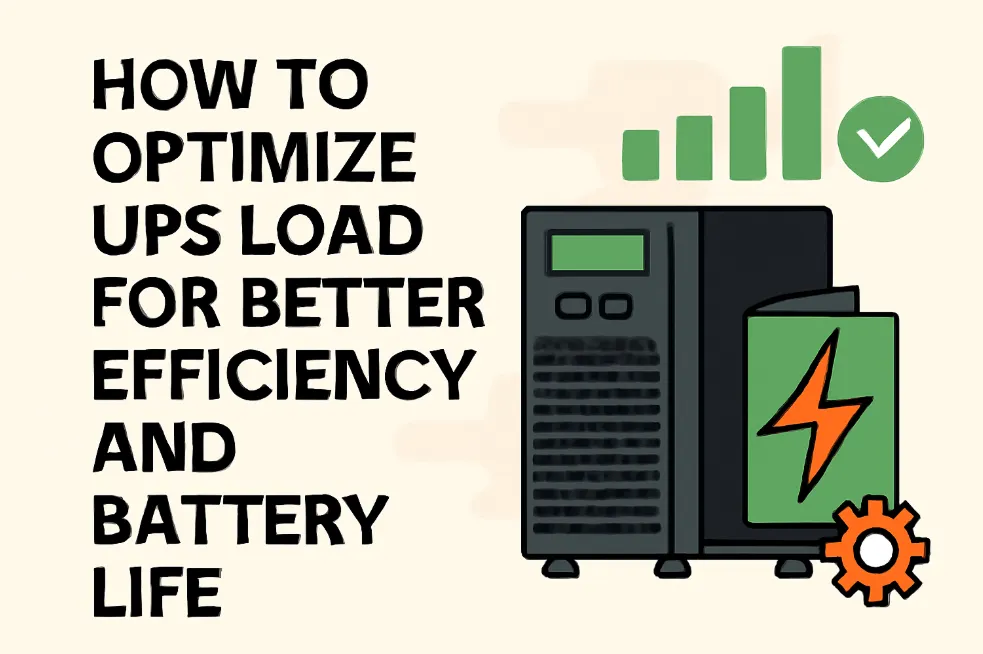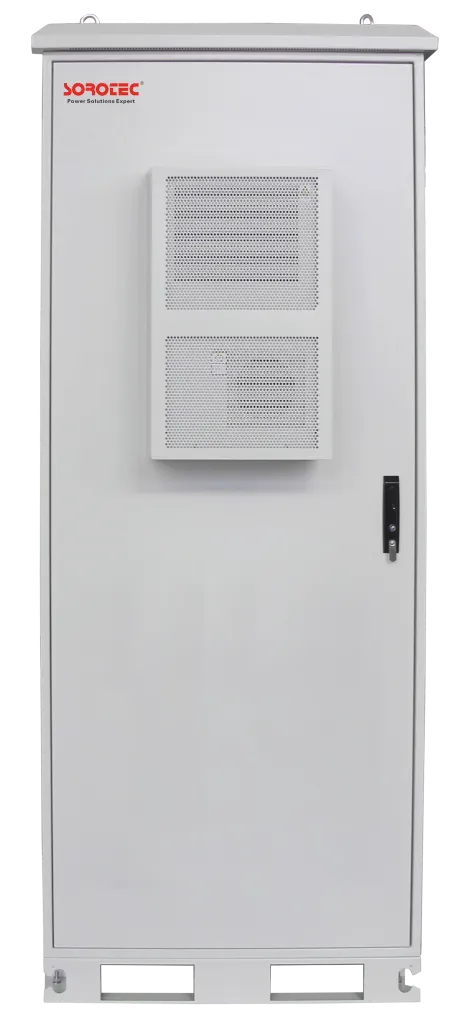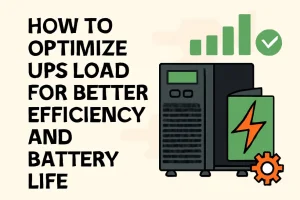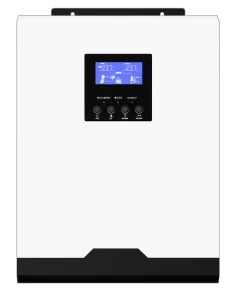In today’s quick-moving, power-hungry world, making sure your uninterruptible power supply (UPS) runs at top efficiency matters a lot. People often count on UPS systems to keep key gear going during blackouts. But if you don’t handle these systems right, especially with load tuning, their strength and long life might suffer.
This guide looks at how UPS load affects battery life and total system performance. It also explains how companies can handle UPS load well to get the best from their setups. We focus on SOROTEC‘s options for big, dependable power systems.

Why is Optimizing UPS Load Crucial for Battery Longevity?
UPS systems aim to give backup power during outages. They keep vital equipment on without breaks. But for this to work well, UPS systems must deal with their load in the right way. For more details on this topic, check out How UPS Load Affects Battery Life and Efficiency – SOROTEC.
Extending Battery Life by Managing Load Effectively
One big effect of bad load handling is on battery life. Loading a UPS too much can cause extra wear on the battery. This cuts its life span and raises how often you need to replace it. You can make the battery last longer by keeping the UPS in its suggested load range. And that leads to savings over time.
Reducing the Frequency of Battery Cycles
Each time the UPS battery starts up because of overload, it’s one more charge-discharge cycle. Over the years, these cycles break down the battery’s power. In the end, this weakens the UPS system’s ability to supply energy when you need it most. Good load handling cuts down on these cycles. So, the battery gets used only in real emergencies. And it lasts much longer.
Avoiding Overloading to Prevent Early Battery Wear
Overloading speeds up damage to a UPS battery. If a UPS keeps getting pushed beyond its design, the battery works harder. And it wears out quicker. On the other hand, balancing the load keeps battery health steady. It also ensures strong performance when the system gets called on.
What Are the Key Factors Affecting UPS Load and Battery Performance?
Many things can change how UPS load hits battery performance. Heat changes, load shifts, and the system’s overall condition are just some vital points. Businesses need to remember these.
Temperature Fluctuations and Their Effect on Battery Health
Heat is a big factor for battery health. A UPS running in very hot or cold spots will struggle to keep the battery’s charge. Batteries break down faster in hotter places. In colder ones, they might not hold power as well. That’s why handling the UPS system’s temperature and ensuring good air flow is as key as load handling.
The Role of Load Variability in System Efficiency
UPS systems handle ups and downs in power needs. But big jumps in load can stress the system. Quick spikes in demand make the UPS push harder. It uses more energy and shortens battery life. On the flip side, steady low loads might mean the system isn’t used enough. And that can cause poor energy changes. Keeping the load even helps make both battery life and energy use better.
Understanding Peak Load and Its Impact on Battery Cycles
Peak loads happen when power demand hits its top. They have a big effect on battery cycles. During peaks, the battery jumps in to meet the extra need. This causes more charging and discharging. And that frequent action cuts the battery’s total life. You can make the battery last longer by spreading power demand more evenly. So, avoid steady peak loads.
How Can You Choose the Right UPS System for Your Load Needs?
Picking the right UPS system is vital for good battery life and system performance. It’s not about grabbing any model. The system must fit your business scale.
SOROTEC On-Grid MPGS Series: A Solution for Large-Scale Load Management
The SOROTEC On-Grid MPGS Series works great for companies that need solid, growable energy fixes. With a range from 50-600 kW+, this series handles big loads without hurting battery life or performance. Its strong build makes sure it deals with changing energy needs while making battery work better.

Selecting the Correct Capacity for Efficient Battery Usage
Match the UPS system’s capacity with your energy needs when you pick one. Going too big or too small leads to poor performance. The SOROTEC On-Grid MPGS Series gives choices to pick the right setup. It meets your load needs and ensures the battery runs well without extra stress.
Key Features of SOROTEC UPS for Energy Savings
SOROTEC’s systems have many features to make energy savings better. They include smart energy handling and live load tracking. These work together to make sure the system uses only needed energy. And it avoids power waste.
How to Monitor UPS Load for Optimal Performance?
Watching UPS load in real time is key to keeping its performance up. Without steady checks, it’s hard to spot when the load gets too high. Or when performance starts to drop.
Implementing Real-Time Load Monitoring Systems
Real-time tracking systems give companies tools to handle UPS load well. You can follow UPS performance by adding smart tracking. Then, make changes as needed before the system overloads or turns inefficient.
Adjusting Load in Response to System Feedback
Many new UPS systems give feedback on how they run. This lets companies tweak their load on the fly. If the system spots poor performance, it can signal for changes. So, operators keep best load levels for top efficiency.
Benefits of Remote Monitoring for Continuous Optimization
Remote tracking is a great tool for companies wanting to stay ahead of UPS problems. With access from afar, operators can check the system’s run from any spot. This allows faster fixes and makes sure the UPS always runs at its best.
How Do Load and Battery Maintenance Interact for Better Efficiency?
Regular upkeep is vital for making battery life longer and improving UPS performance. The link between load and upkeep is a main factor in the system’s total efficiency.
Regular Battery Health Checks to Support Load Optimization
Routine battery checks are needed to make sure the UPS runs well. Companies can spot early signs of wear or issues. And that helps avoid sudden failures that might stop work and waste energy.
Scheduled Load Testing for Prolonged Battery Life
Planned load tests are a forward step that helps companies ensure their UPS systems don’t face too much stress. You can mimic real conditions to see how the system handles different load levels. And make sure it works as planned.
Preventative Measures to Avoid Overloading and System Failures
Preventive upkeep is key to keeping the UPS in good shape. This means cleaning the gear often, ensuring good air flow, and skipping overloads. These steps cut battery life risks and boost system trust.
What Are the Benefits of Optimizing UPS Load for Your Business?
Tuning UPS load isn’t just a tech need. It also brings real business gains. From cost cuts to better system trust, handling UPS load is a smart spend on work efficiency.
Lower Operational Costs with Better UPS Load Management
Companies cut total energy use by tuning UPS load. A well-handled system doesn’t waste power on needless surges or low use. And that leads to smaller electricity bills and running costs.
Increased Battery Runtime Leading to Fewer Replacements
Good load handling means fewer charge cycles for the UPS battery. This brings longer battery life. So, companies save cash by skipping frequent battery swaps. And they make sure the system stays solid during blackouts.
Enhanced Energy Efficiency and Sustainability in Operations
Businesses see less energy waste when UPS systems get tuned for load. This not only cuts costs but also backs green efforts. It lowers the total carbon mark of work.
FAQ
Q1: How often should I monitor my UPS load?
A: Watching your UPS load should go on all the time. But regular checks at least once a day or week (based on your system) can help you find problems before they turn bad.
Q2: What are the common signs of an overloaded UPS system?
A: Usual signs include battery drain, frequent alarms, and poor power use. If your UPS system often pushes harder than needed, it’s time to tweak the load.
Q3: Can UPS load optimization be automated?
A: Yes, new UPS systems often have built-in features for auto load tweaks. This lets companies make their UPS systems better without hand work. And it ensures the system always runs at top efficiency.








